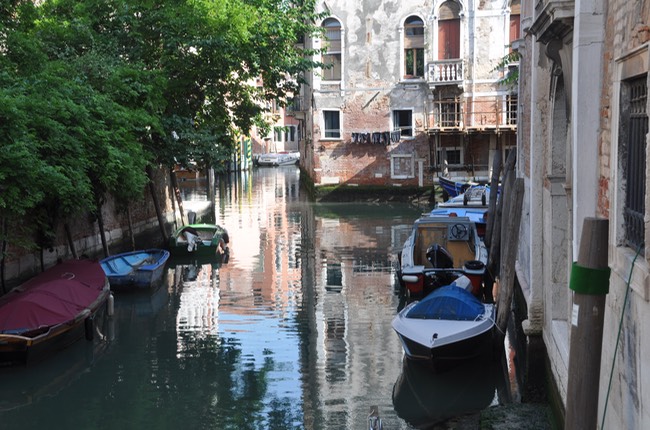Viva Italia
Bella Napoli
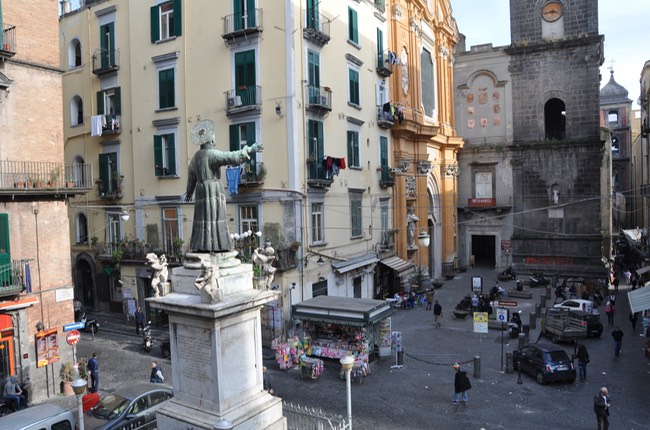
It is a short seventy minutes on a direct train from Rome to Naples, but that seventy minutes brings you to a different world altogether. It’s hard to define what it is about this city that I love so much. It is large and noisy, full of garbage and motorcycles, and definitely stressful to navigate. But the minute I stepped out of the train station, and felt the bright spring sunshine and the touch of humidity in the air, and saw the tall, pastel-coloured buildings, I felt myself smiling and thinking: I am back.
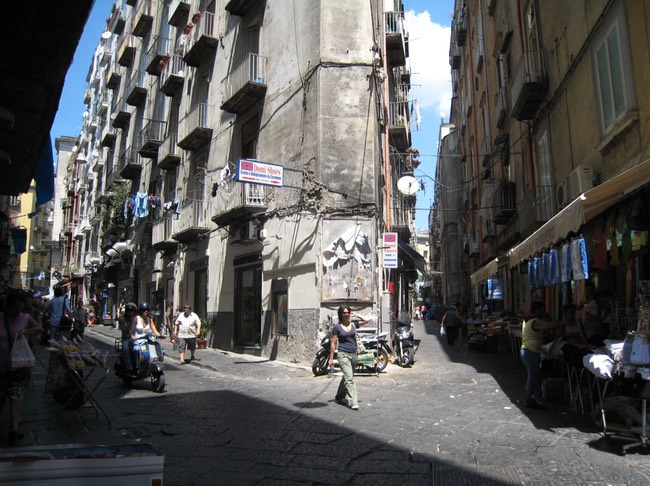
The buildings are tall, in the colours of the Mediterranean, but faded and peeling. Laundry hangs from the windows and balconies, and across the narrow streets of the old quarter. This area, known as Spaccanapoli, extends from the train station to the foot of the Vomero hill, and is as quintessential a southern Italian city as one can imagine. The areas closer to the station are quieter, largely untouristed, and decidedly smelly. But once past the Via Duomo, there is a subtle change, and the characteristic cobblestone streets are lined with shops and pizzerie.
These streets, shaded by tall buildings, are often more narrow than the lane behind my house at home; and yet, periodically, a car or even small truck will force its way through the crowds of pedestrians, patiently moving forward while we swirl around both sides of it like the water moving around a large rock. Motorcycles are everywhere, less patient than the cars, more willing to lean on the horn if they aren’t getting through quickly enough.
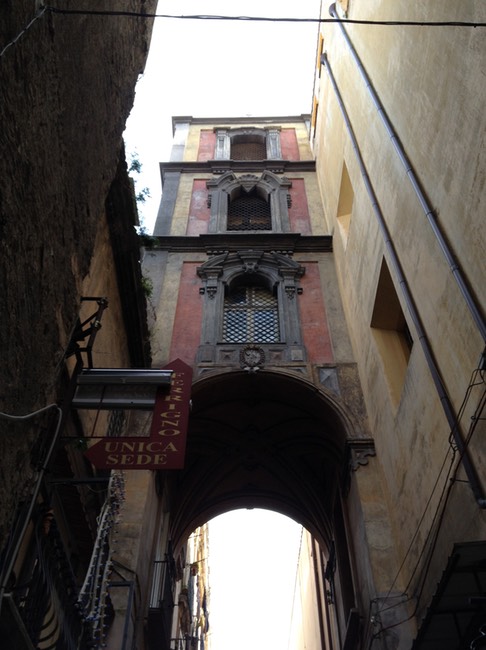
There are two main streets that wind their way through Spaccanapoli. One is Via dei Tribunali; the other is the combined route of Via San Biagio dei Librai and its continuation, Via Benedetto Croce. These two routes are joined by the short, picturesque Via San Gregorio Armeno. We walked down this crooked little street, which passes through a tall arch halfway down the hill; it was our first destination on our day trip from Rome, as we were in search of additions to our Italian nativity scene, first bought here almost five years ago.
The street is lined with these shops, some of which sell more mass-produced items, but some of which are highly artisanal. Look for the shops with workbenches at the back; those will be selling figurines made in-house, and they are particularly beautiful. I bought sheep and a shepherd, and a pair of angels, to supplement my original stable-scene; my son bought some market figures for his Christmas village.
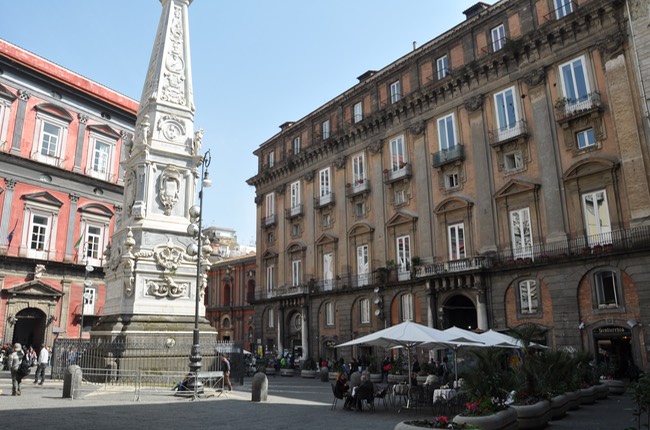
Further along, Via San Biago runs into the lovely Piazza San Domenico Maggiore. My memories of this piazza go back to our first visit to Napoli, when our son was not quite four, and it was a place where we could safely let him run, kicking his pink inflatable soccer ball around and around the piazza. The second time, we stayed in an apartment a few steps away, and we spent many an hour here at a shady café table, playing cards and enjoying a glass of limoncello. In this square is located the outstanding Pasticcieria Scaturchio, maker of heavenly pastry. This time, we sat in the square with our sfogliatelle, layer upon layer of thin pastry crust, with a rich, creamy centre.
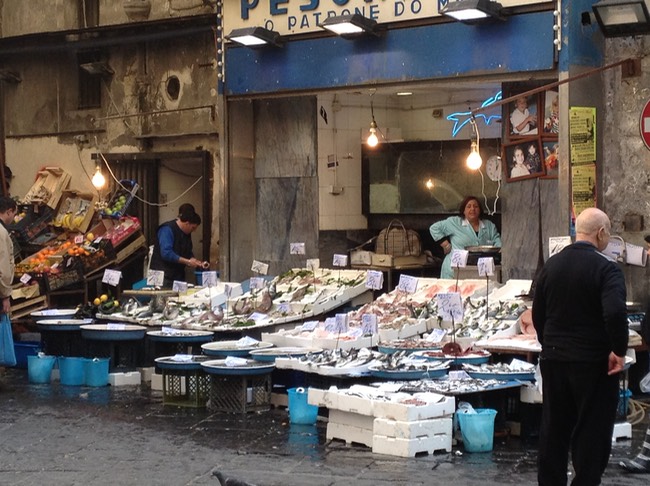
At the end of the centro storico, we passed through Via Pignasecca, where beautiful fresh produce, already in season even in March, was spread out for sale: tomatoes, artichokes, fava beans, flowering zucchine, and all kinds of greens. Just beyond the market is the funicular train that runs up the hill to the Vomero district, where we strolled peaceful streets and enjoyed spectacular views over Napoli, the harbour, and the not-too-distant Vesuvio. There is a small piazza where tour buses stop (we laughed at the sign forbidding the playing of soccer, and at all the soccer balls that lay further down the hill), but we took an expensive but charming table at a bar with a big patio, and drank limoncello and admired the view.

We went back down the hill by way of the scala, or stairway, that winds down the hillside past small quiet streets and houses. On our way back through Spaccanapoli, we discovered that the large Basilica di San Paolo Maggiore was open (for the first time in three visits!) so we took the opportunity to climb its stairs and admire the lovely Gothic interior. Then, thoroughly exhausted, we went to the incomparable Pizzeria di Matteo, where we were given a warm welcome and a corner table, and enjoyed some of the best pizza in the world.
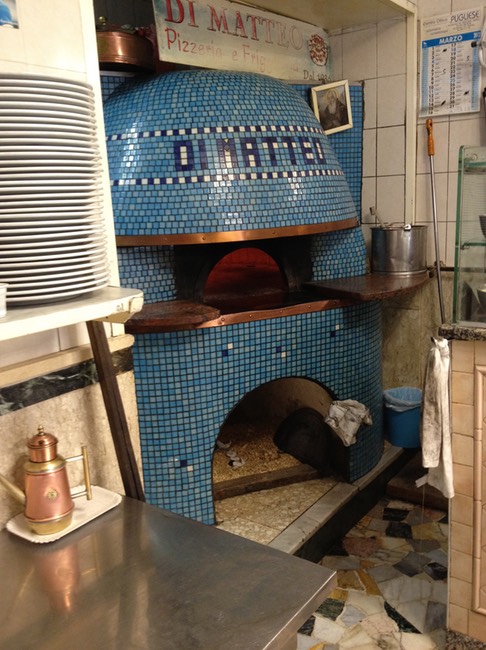
Not everyone may agree, but in our view, la vera pizza napoletana is simply the best pizza anywhere. The crusts are thin in the centre, light and puffy around the outside, blackened and crisp in places, and soft and chewy overall. The classic toppings are perfection; I would rather eat an excellent pizza margherita than all the gourmet toppings that the new world can provide. We have had pizza in North America that was certified as la vera pizza napoletana, but it has never been as delicious as the pizza we have enjoyed in Napoli. An excellent reason for a seventy-minute train ride from Rome!
There is no place quite like Napoli. The city struggles nowadays with the myriad challenges of poverty and crime, and the buildings look like they haven’t been painted in a hundred years. In my mind I see it as it would have been long ago, a beautiful old city on one of the most beautiful harbours in the world. Its current reality is more gritty, but its atmosphere is exhilarating– belligerent, energetic, defiant, joyful.
Photos: Spaccanapoli; streets of old Napoli; Via San Gregorio Armeno; Piazza San Domenico Maggiore; fish market on Via Pignasecca; a found soccer ball on the Vomero hillside; Basilica di San Paolo Maggiore; oven at Pizzeria di Matteo; view over Napoli

Apartment by the Trevi
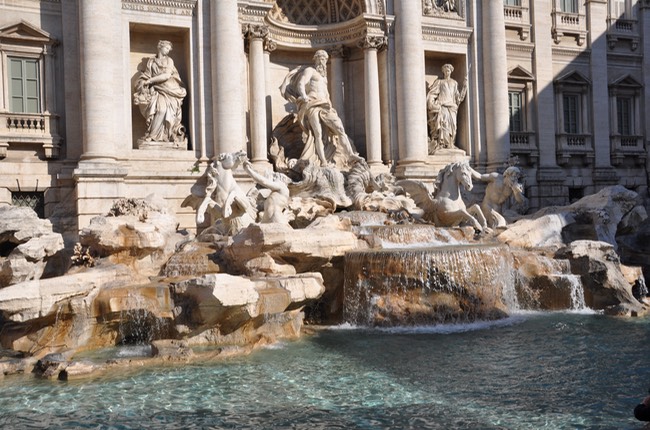
On a spontaneous spring break trip to Rome, we are staying in a charming apartment just a block from the Trevi Fountain. We have been here. before, but only for brief spells of two or three days, and always in the summer, which is possibly the least advantageous time to visit Rome. We have staggered through the Foro Romano in forty degree temperatures, struggled to sleep at night with inadequate air conditioning, and skipped the Vatican Museum altogether because of the crowds. This week, we are enjoying lovely spring weather, with mostly sunny days and comfortable temperatures. Some evenings, we have even been able to eat dinner on restaurant patios, a treat that we had not expected at this time of year. We have sat outside at caffè-bars in the afternoon, enjoying white wine and snacks.
We are seeing fewer visitors than we have experienced in the summer, but this is not to claim that there are no people here. One of the challenges that we face multiple times each day is that of fighting our way through the crowds around the Trevi to get back to our apartment. From midday on, and particularly in the evening, the tiny piazza around the fountain is jammed with people, much as we remember it in July and August. However, we needn’t go far to feel as though we are out of the tourist zones.
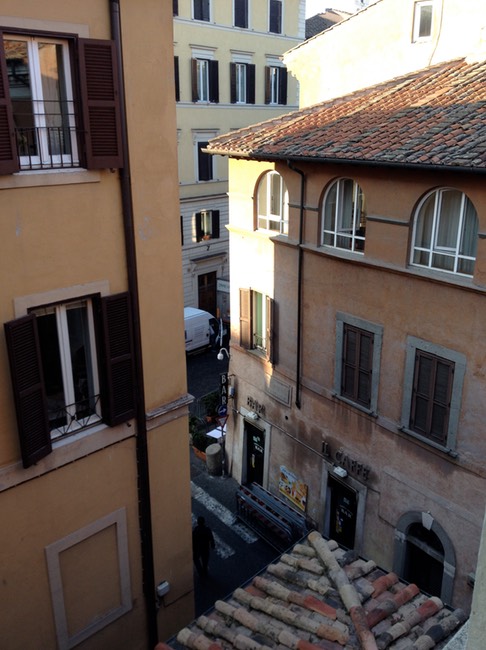
The street on which our apartment lies leads directly to the Trevi Fountain. It is lined with shops catering to the tourist trade, selling souvenirs and postcards and gift items of every kind. It also features, across the street from our apartment, a small bar-caffè. In the morning, we go there for a quick espresso or cappuccino and sometimes a breakfast pastry. In the morning, this little place is seemingly patronized only by Italians. It is not a romantic place with a view or a charming terrace, but simply a bar, crowded at times, filled with Italians downing their morning brew, served by women who are courteous but matter-of-fact. We love it. Each morning, we stand at the bar and imagine that we could almost pass for Italians. This is an amusing fantasy given our beginning-level command of the language, and the fact that my husband is a big man of Dutch ancestry, and our son takes after him in build; we are clearly not Italian.
A couple of blocks past Piazza di Trevi, up the Via Poli, is a supermercato of the Despar chain. This excellent store has all the useful grocery and household items, plus a complete wine section downstairs, and it is open seven days a week. By the time we reach that end of Via Poli, we already feel that we have left the Trevi madness behind, and we stock up on water, yogurt, juice, and other breakfast and snack basics (as well as a few bottles of wine!)
One of the things worth fighting our way past the Trevi for is the wonderful Antico Forno at the beginning of Via delle Muratte. Not only can we get delicious rustic loaves of bread and freshly baked slabs of Roman style pizza from the wood oven, but they have a small grocery store as well, including a deli counter and a wine section. I even bought a corkscrew there (“Souvenir of Antico Forno”), when we discovered on the point of opening the wine that our apartment didn’t have one.
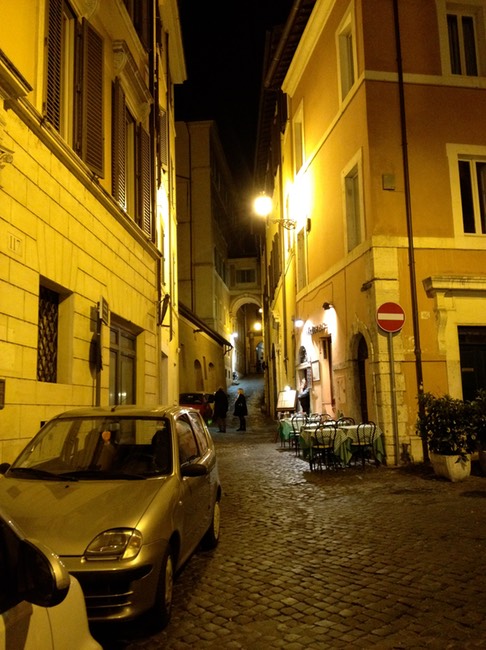
We have been able to find peaceful, pleasant restaurants in the heart of historic Rome, simply by walking up quieter streets that don’t boast large terraces or multiple rows of seating. Suddenly, around a bend or corner, we will spot a cluster of tables, and there will be a pleasant-looking pizzeria or trattoria, with a welcoming look and not too much activity around it. The food has always been good, and in some cases, excellent.
We can open our windows in the morning and listen to the sounds of Rome: the raising of metal security doors, the clatter of trucks being unloaded, the sound of footsteps on cobblestones, Italian voices echoing off the high-walled buildings. We tell the time by bells of Santi Vincenzo e Anastasio next to the fountain, which chime the hours and the quarters. Although we are staying steps from what is apparently the single most visited thousand-square-metre space in all of Rome, we are not finding it hard to find space away from the tour groups, and feel as though we are spending time in a real place where people work and live.
Photos: Rome's most famous fountain; unnamed bar-caffè near the Trevi; hidden trattoria
Finding La Serenissima
Six-thirty a.m. on the Rio del Gafaro, a small canal that marks the boundary between Santa Croce and Dorsoduro. The canal is as still as glass, and only the occasional person passes by, their footsteps echoing along the fondamenta. Two women arrive to open up the café, bringing out tables and chairs. Where the canal intersects with the Rio dei Tolentini, boats can be seen passing, but none are yet coming this way. Boat horns honk in the distance, and occasional voices ring out. These sounds only momentarily break a stillness that is profound. Young men come out with long-handled, whisk-like brooms, to sweep the sidewalks.
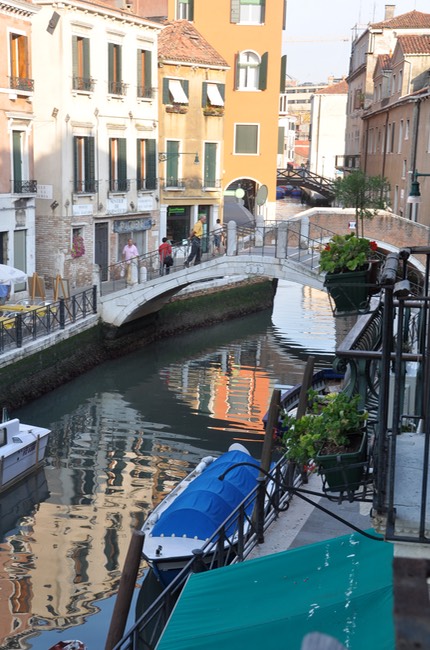
Around eight o’clock, the bells begin to ring from the nearby churches. Venezia contains an incredible number of churches in a relatively small area, and when the bells begin to ring, always one or two at first, with others joining in, as all the clocks are set slightly differently, it creates a magical reverberation of music from all directions. After several minutes of glorious chiming, they gradually fade away, but the early morning stillness is definitely over. Now the sounds of voices and footsteps, boats, and wagons clattering over the steps of the bridges, is continual. The day is in full swing.
Breakfast at the little café could be a quick espresso at the bar, but if there is no hurry, we can sit at a canalside table and watch the boats that make their way into the city. One little boat carries a single workman with a wheelbarrow, while a larger boat carries huge sacks of flour, and still another, crates of bottled water. As the sun begins to appear over the tops of the tall buildings opposite, the table becomes too warm for comfort, and breakfast is over.
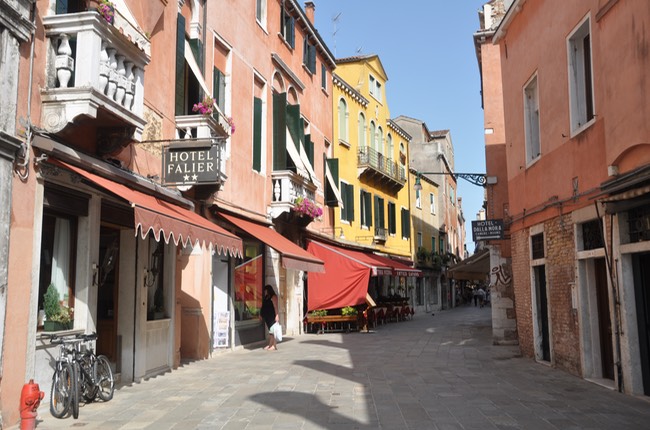
The signs indicating the names of canals and campos, streets and sestieres, are peeling and sometimes almost illegible. Buildings look aged and failing, a shadow of the glorious city-state past. The canals are plied by motor craft of all kinds, from vaporetti to garbage boats, as well as the elegant gondole. And yet, there is a magic about the place.
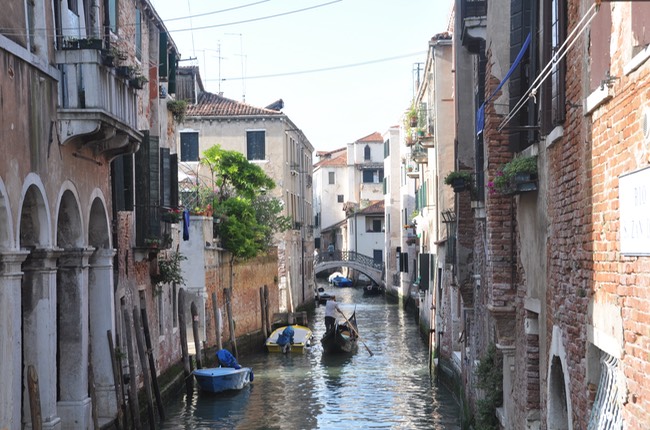
We walked along quiet, narrow streets, where our voices echoed off the stone walls, and we came unexpectedly upon tiny, empty campos and small cafés with tables scattered into the street. We walked into solid, grey churches, entering in from the sunlight into the dim coolness, where the walls and ceilings were painted in gold and covered in art. We crossed over narrow canals by way of small stone bridges, where we might see a gondola appear suddenly from around a bend in the waterway, or hear the gentle humming of an outboard motor as a dinghy made its way beneath us. We travelled down the grand canal by vaporetto, watching the bright sunshine light up the elderly, gracious buildings, and listened to the hum of activity so like, and yet entirely unlike, any other busy street in the world.
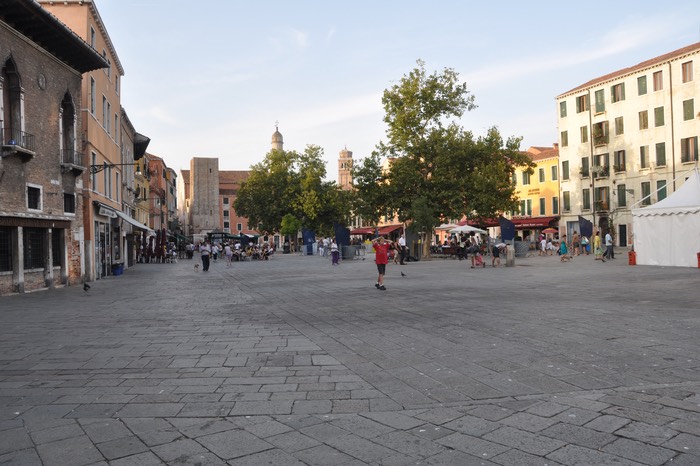
Time and again, we found ourselves returning to the central space of our neighbourhood, the Campo Santa Margherita. It is long and vaguely trapezoidal, with large trees and benches in the centre, and lined with a variety of restaurants and bars, all with ample outdoor seating. There is also the outstanding and popular Pizza al Vole, whose takeaway pizza boxes are found in stacks around the campo’s overflowing trash cans each morning.
We passed through the campo on our way to the vaporetti and traghetti stops of the Grand Canal, stopping at the tiny grocery store for bottled water. We relaxed on the shaded benches, watching the atmosphere change at different times of day. In the morning, people came to shop at the lively fish and produce market, and in the afternoon, they had lunch and congregated in the shade. A pair of elderly ladies, one in a wheelchair, chatted quietly beneath a tree, while some boys kicked a soccer ball hard against the stone wall of one of the buildings– as all the windows are protected by iron grills, there is no worry about breaking glass, and the boys played happily away. In the evening, people filled the restaurants, benches, and steps of the campo, eating, drinking, and listening to live music. On our way home at night, we never failed to stop at Gelato Il Doge, for some of the best (and best-priced) gelato in Venice.
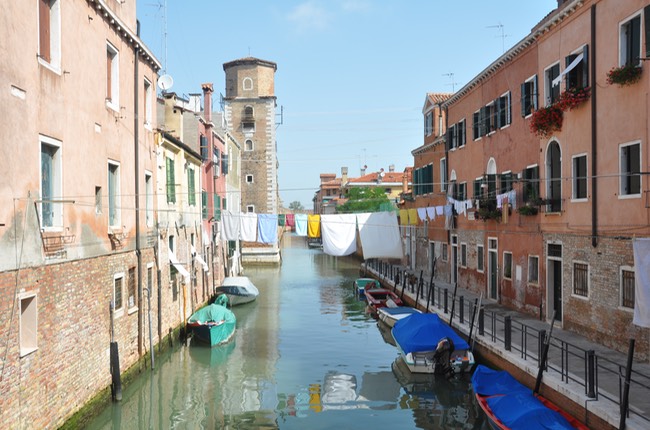
Other than our snacks in Campo Santa Margherita, we did our eating and drinking in the quieter neighbourhoods, away from the sightseeing areas. In the Calle Lunga San Barnaba, we dined in a restaurant that served no seafood, and nothing authentically “Venetian”, but their own culinary twists on Italian cooking with a touch of fusion. It was a wonderful meal, and we could imagine being locals out for a pleasant evening (they can’t eat squid-ink risotto every night!). We enjoyed prosecco and fanta in a small café in the quiet Campo Nazario Sauro, and beer in a shady café on the main thoroughfare of Castello. The Rio di Sant’Anna is lined with lively bars and shops, and a market where produce and fish are sold from both stands and boats. Roads and canals in Castello are wider and straighter, the buildings are less ancient, and the air smells freshly of salt water rather than damp stone.
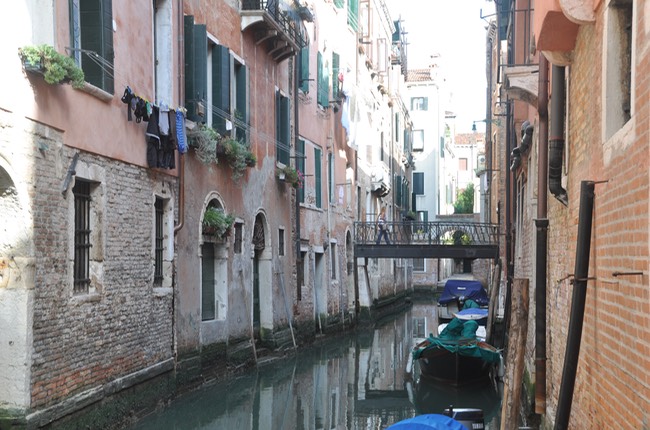
This was our Venezia, replete with beauty and grace, and with a sense not only of history, but of otherworldliness. We experienced vigour, colour, and at times, a calm and profound stillness. We found that it is not necessary to travel back in time to reach La Seremissima, for it is still a part of the Venice of today.
Photos: canal in San Polo; Rio del Gafaro; Salizada San Pantalon; gondolier; Campo Santa Margherita; Rio di Sant' Anna, Castello; San Polo

